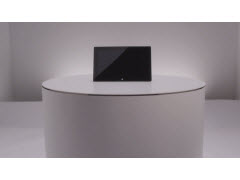Surface: Why Microsoft's big mystery turns out to be a big mistake

Following several days of hype after journalists from around the world were invited to a mysterious "major Microsoft announcement" that they were promised, "you will not want to miss," Microsoft unveils a... tablet.
Oh Microsoft, what were you thinking?
Microsoft Surface tablet (Gallery)
| Image Gallery: Microsoft Surface tablet |  | |||||
Let's start with the hardware.
We don't have a lot of information to go on because it seems that Microsoft either wasn't ready to, or wasn't willing to share much about the specs of the hardware it was announcing. That's troubling -- and suggests the hardware may still be in a state of flux.
This would make sense given that Windows 8 and Windows RT -- yes, that's what's going to be powering these tablets -- is still months away.
Here's what we know.
The Microsoft tablet -- called "Surface" -- comes in two flavors. There's an x86-powered version that runs Windows 8 Pro based around an unidentified Intel "Ivy Bridge" Core processor, and an ARM version running Windows RT based on an unidentified ARM processor.
Both have a 10.6-inch screen, with the x86 version running at full-HD (1080p) and the ARM version running at HD (720p). Both are thin, both are light. Both have an integrated kickstand, both have a complement of ports, including a full-sized USB 2.0 port. (The Pro model has USB 3.0.) Both support storage expansion through the use of micro-SD cards.
In a homage to Apple, both will support a magnetically attachable cover. Unlike the Apple cover, it's a cover with a difference. This cover comes complete with an integrated keyboard and trackpad, which is certainly innovative, but it remains to be seen if this keyboard is any good.
They're just tablets. They're shaped like tablets and have stuff inside them that we've come to expect tablets to have.
There's no word on price beyond a statement from Microsoft saying that they are "expected to be competitive with a comparable ARM tablet or Intel ultrabook-class PC". This puts the ARM version in the $600 price bracket and the x86 in at around $1,000 -- give or take.
Throw away the kickstand, the keyboard and the trackpad and they're like every other ARM tablet or Intel Ultrabook-class PC we've seen so far.
If the mistakes ended there then things might not be so bad. But why stop making mistakes when there's scope to make many more?
Let's start with the mistake of annoying every hardware OEM that Microsoft is relying on to do a good job of pushing Windows 8 out to consumers and enterprise.
While PC OEMs don't really have the option of kicking Windows to the curb and going with another platform -- what, Linux? -- it's a really odd time for Microsoft to start selling branded hardware. The only OEM that's going to be happy here is whoever Microsoft has contracted to build Surface tablets, and if these don't sell well, that happiness could be short-lived.
Then there's the mistake of releasing two near-identical tablets powered by two different operating systems and with two very different set of capabilities. Which one should buyers -- consumers and enterprise alike -- go for?
For the uninformed, price might be the deciding factor, and that could lead them to buy something completely inappropriate for their needs. But if you're trying to make an informed decision then it's tough to know which to go for. And at this stage, that decision is made even harder by the information vacuum surrounding these two devices, especially regarding battery life, and more crucially: price.
Then there's the mistake of announcing this tablet far too soon. With Windows 8 only a matter of months away, I'm stumped as to why Microsoft chose to unveil this now. People have short attention spans. Unless Microsoft can keep up the pressure, Surface will be long forgotten by the time Windows 8 and Windows RT ships.
And what's the deal with the part-cover, part-keyboard? I can understand that Microsoft was looking for something -- no matter how novel or gimmicky -- to differentiate the Surface from other Windows tablets, but that keyboard is an admission of failure.
It tells the world that no matter how much effort Microsoft has put into making Windows 8 ready for tablets, people still need a keyboard and a trackpad. On the flip side, most iPad owners never think about hooking a keyboard up to their tablet; Microsoft feels the need to bundle one with every tablet.
Microsoft's big mystery event turned out to be an announcement for a tablet that won't ship for months, and about which Microsoft doesn't yet seem willing to talk in any detail.
But who invited whom to this event? When I do my usual end of year "tech flops" roundup, I fully expect Microsoft Surface tablets to make their way onto the list.
Image source: CNET, Microsoft.
Related:
- With Surface tablet, Microsoft breaks tradition
- Microsoft's new Surface tablets make a solid first impression
- Can Microsoft build a tablet that people will want to buy?
- Microsoft Surface tablets: Obviously designed for me
- Will Microsoft Surface for Windows 8 Pro tablets be competition for Ultrabooks?
- Okay, let me get this straight. Did Microsoft just kill the Windows tablet OEM market?
- Surface: Microsoft, What the Hell is Wrong With You?